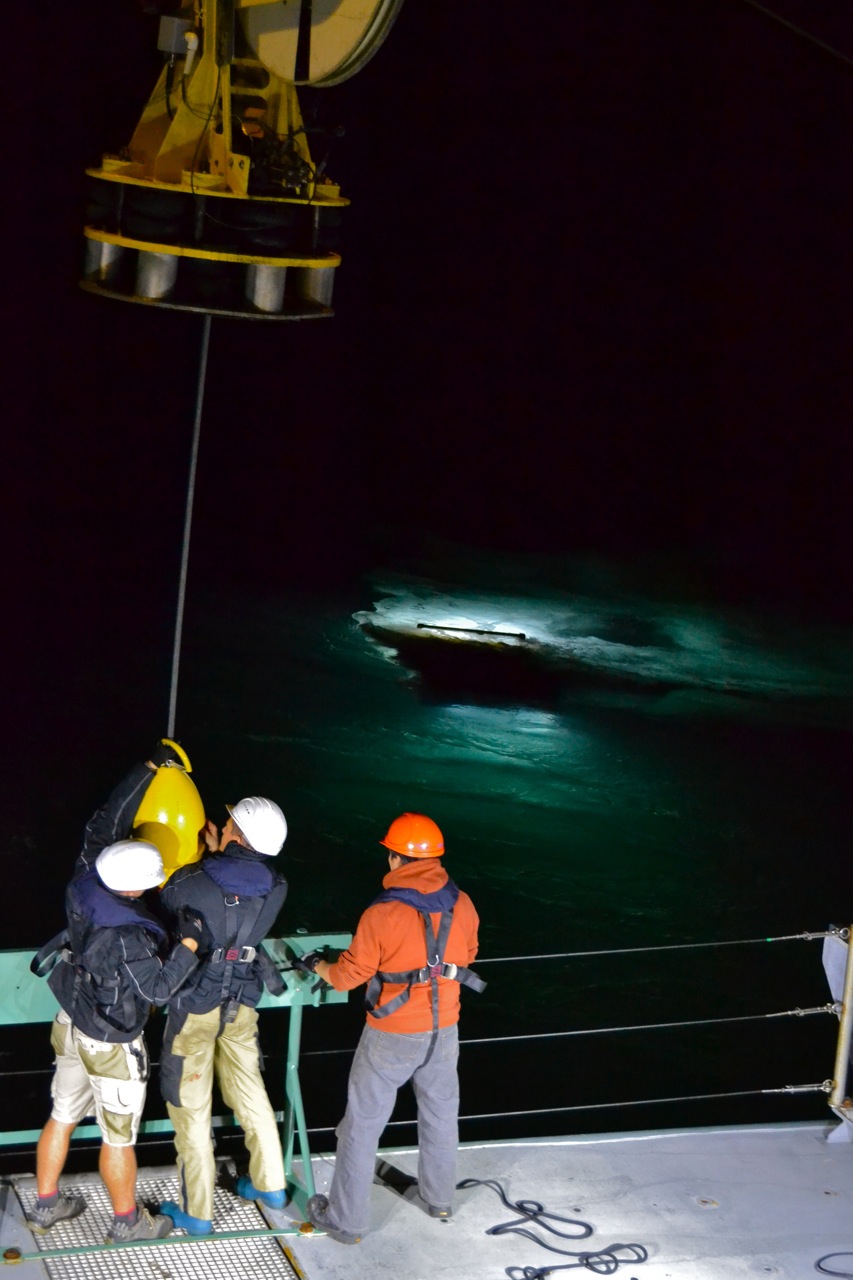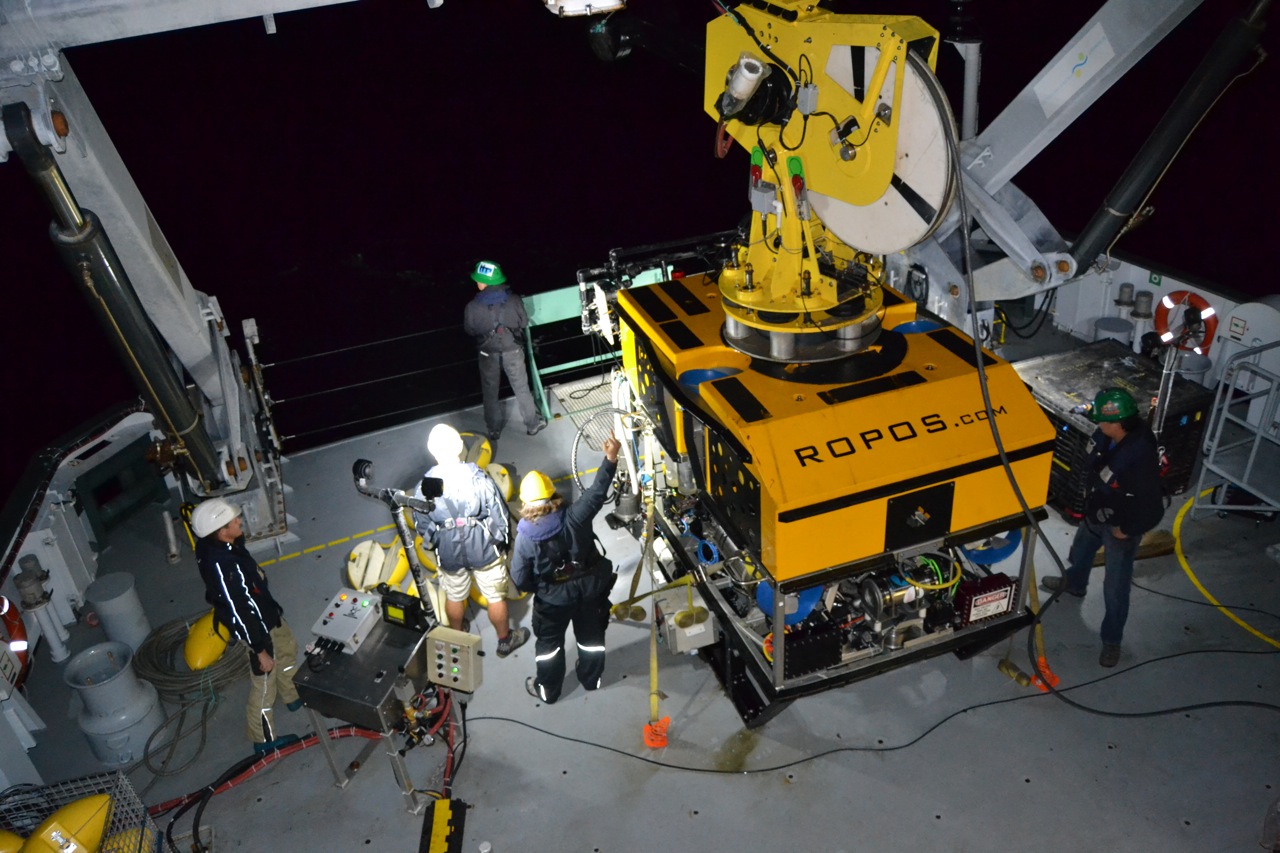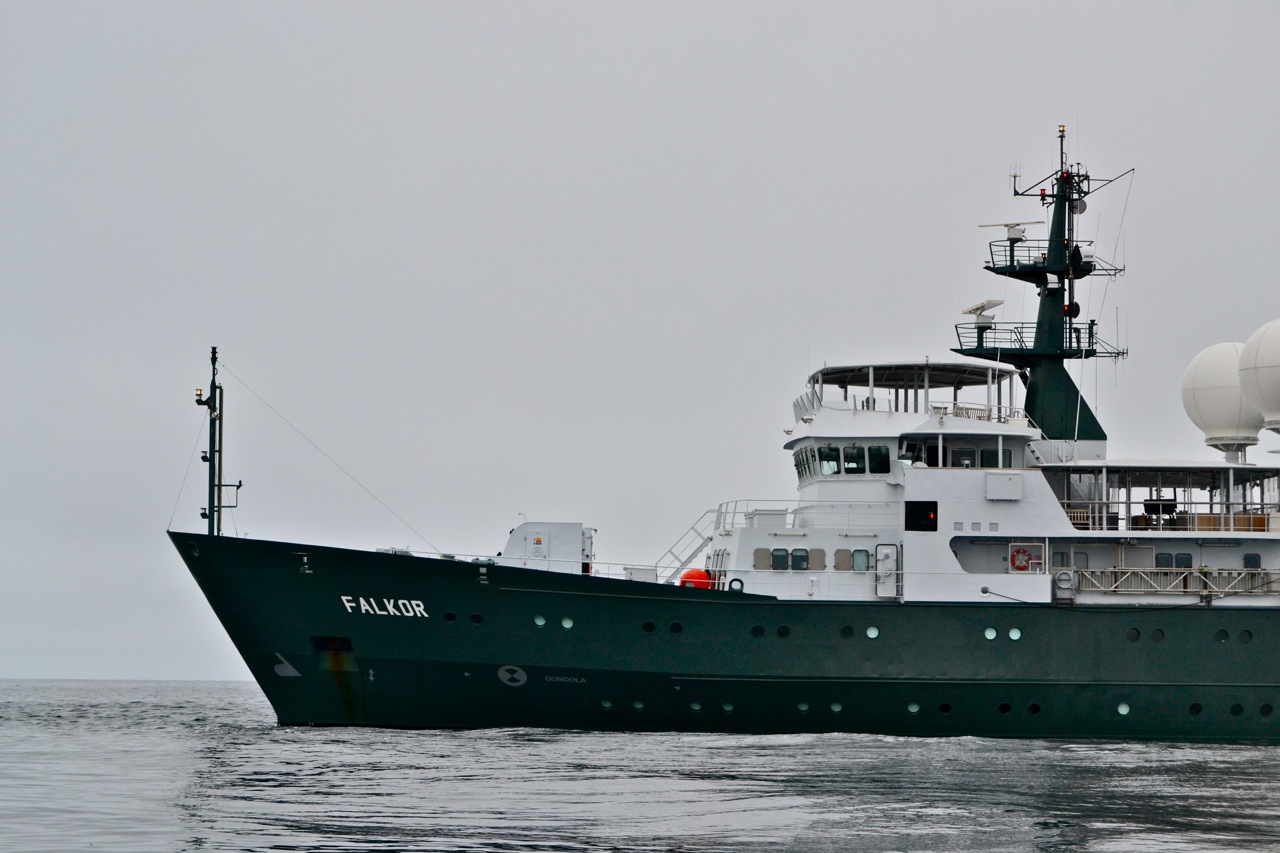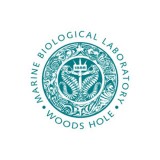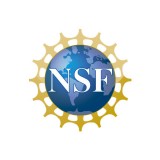In recent years, scientists have begun to recognize that seemingly isolated rocks beneath the seafloor are a haven for microbial life. Biological activity in this subseafloor realm likely impacts ocean chemistry and the ocean’s critical capacity to store carbon and maintain the planet’s habitability. Our understanding of this activity, currently is in its infancy, will substantially expand thanks to the next Falkor mission.
On September 22, Falkor departed Victoria, British Columbia with the ROPOS remotely operated vehicle, headed to the underwater volcano called Axial Seamount, about 575 kilometers to the southwest. There, a team began an unprecedented study of the microbes and viruses that live within the rocky layers beneath the seafloor.
Julie Huber at the Marine Biological Laboratory led the new collaboration with Schmidt Ocean Institute, which also involves Huber’s colleagues from University of Washington, NOAA Pacific Marine Environmental Laboratory, University of Massachusetts, Amherst, and J. Craig Venter Institute.
Chemical Energy
Unlike most of the ocean, the subseafloor environment does not directly receive organic matter derived from photosynthesis. The food webs in the subseafloor instead begin with microbes able to produce energy and food from chemicals and inorganic carbon, or chemosynthesis.
Some estimates suggest there could be up to ten times more microbial cells in the subseafloor than in the ocean itself. Yet, the associated potential for production of new carbon is rarely considered in traditional oceanographic models of carbon cycling or microbial food webs. That is because we know so little about this underexplored and potentially ubiquitous microbial habitat.
The functional consequences of an extensive population of microbes living in the subseafloor remains unknown, and we can’t yet say how these organisms interact with one another and influence the biogeochemistry of the oceans.
Microbes aren’t the whole story in the subseafloor. Viruses—organisms that are only able to survive within the living cells of a host—are likely plentiful there, although we know almost nothing about them. That’s despite the fact that viral infection of microbial cells can cause them to break up, or lyse, releasing carbon and other nutrients back into the subseafloor. In addition, through the infection process, viruses may also be important contributors of new genes to microbes, with significant historic effects on their evolution.
Subseafloor Window
The lack of subseafloor research is in part because that realm is so difficult to access. But the water that travels within crustal layers and emerges at hydrothermal vent fields offers an accessible window. One well-known hotspot for such activity is Axial Seamount, a natural working laboratory that offers a range of vents with differing temperatures and chemistries.
Axial includes multiple spectacular “black smokers” chimneys. But the super heated, cloudy waters from these vents are too hot to support life, so they’ll serve only as references for the chemistry of the waters cycling through the otherwise inaccessible rocky layers below. The focus will instead be on collecting samples from the cooler surrounding vent sites because these waters contain the microbes and viruses that live in the rocky subsurface layers.
The team ran a wide range of analyses and experiments using these samples, including identifying and quantifying microbes and viruses; determining what genes they contain—their gene repertoires; establishing microbial metabolic rates; and measuring microbial and viral chemical signatures.
Critical Technology
Besides access, a key challenge of studying subseafloor microbes and viruses is maintaining the right temperature and pressure conditions where they live so that they can be studied. To do that, the team, with funding from the Marine Microbiology Initiative at the Gordon and Betty Moore Foundation (GBMF3297), used two specialized samplers that will be installed on ROPOS.
The Hydrothermal Fluid Particle Sampler filtered water samples to either collect vent fluids for chemical analyses and enrichment experiments on the ship, or it was used to collect and preserve microbial samples at the seafloor for later genetic analyses. A Large Volume Water Sampler (LVWS) can take the huge, roughly 200-literhuge ~200-liter samples needed to get sufficient quantities of viruses to allow their manipulation and study.
The team also collected samples from gushing hydrothermal vents using an isobaric gas-tight (IGT) sampler device that can be used in water temperatures up to 400°C. It is designed for work at vents, but was also used to sample the Deepwater Horizon spill’s seafloor outflow.
The team collected samples at venting sites representing a set range of temperatures from about 12 to 15°C. One of the main goals with the microbial work was to get direct measurements of which microbes from different sites are actively fixing inorganic carbon. This involved incubating vent fluids with specially labeled inorganic carbon as a starting point for their chemosynthesis.
Among other work aboard Falkor were “challenge” experiments where the team estimated rates at which viruses are able to kill microbes to better understand what role viruses play in governing subseafloor carbon cycling.
Collaborative Model
By combining data from the full range of experiments and analyses, and working with researchers on shore, the team began developing a new model of microbial activity within subseafloor ecosystems. This allowed them to begin assessing the microbes’ impacts on carbon cycling to a degree never before possible.
The dives needed to accomplish this work were all set against the spectacular backdrop of Axial Seamount, including hydrothermal vents with their unique species like tubeworms. We posted regular updates and photos from the team at the cruise blog (click on Cruise Log, upper left corner), and we live streamed all the ROPOS dives.
Support for research and technology development related to this expedition was provided by the National Science Foundation, the Marine Biological Laboratory, the University of Massachusetts, Amherst, theUniversity of Washington, the J. Craig Venter Institute, and the Gordon and Betty Moore Foundation.
Data & Publications
Shipboard chemistry analyses, and microbial and viral counts can be found at the Marine Biological Labratory (MBL) Josephine Bay Paul Center.
ROV ROPOS Dives can be found on You Tube.
Sampling sites, Microbial eukaryotic diversity, and thermophile abundance are being archived at BCO-DMO.
The resulting shipboard-collected dataset is being archived at Rolling Deck to Repository.
Axial Viral Community Raw Sequences are archived at NCBI.
Metagenomes and Metatranscriptomes from the diffuse hydrotherma vents of Axial Seamount are archived at the European Nucleotide Archive.
RNA-based stable isotope probing metatranscriptomics from Axial Seamount Marker 113 are archived at the European Nucleotide Archive.
The project page includes Code and sequence analyses available on Github!
- Fortunao, Carolina and Julie Huber (2016). Coupled RNA-SIP and Metatranscriptomics of Active Chemolithoautotrophic Communities at a Deep-sea Hydrothermal Vent, The ISME Journal, pp 1-14. doi: 10.1038/ismej.2015.258 [This publication is OPEN ACCESS.]
- Cruise Report: Axial Seamount
- Fortunato, C.S. and coauthors. (2014) Using RNA-SIP and metatranscriptomics to determine the active autotrophic subseafloor microbial communities at Axial Seamount. International Society for Microbial Ecology 15th International Symposium, Seoul, South Korea.
- Holden, J.F. and coauthors. (2014). Growth and methane production by high-temperature methanogens in hydrothermal regions of the subseafloor. Korean Institute for Ocean Science and Technology, Ansan, South Korea & Department of Marine and Coastal Sciences, Rutgers University, New Brunswick, NJ, USA & Program in Atmospheres, Oceans, and Climate, Massachusetts Institute of Technology, Cambridge, MA, USA.
- Holden, J.F. and coauthors. (2014). Reactive transport model of growth and methane production by high-temperature methanogens in hydrothermal regions of the subseafloor. Ninth International Symposium on Subsurface Microbiology, Pacific Grove, CA, USA.
- Huber, J.A. and coauthors. (2014). Application of RNA Stable Isotope Probing (SIP) to link community activity with microorganisms responsible for autotrophy in the subseafloor at Axial Seamount. AGU Fall Meeting, San Francisco, CA, USA.
- Huber, Julie, Christopher K. Algar, Lisa Zeigler Allen, David A. Butterfield, Caroline S. Fortunato, James F. Holden, Benjamin I. Larson, Giora K. Proskurowski, Lucy C. Stewart, Begum C. Topҫuoḡlu, and Joseph J. Vallino. 2014, Investigating Microbes, Viruses, and Carbon Acroos Thermal and Chemical Gradients in the Subseafloor at Axial Seamount. Poster Presentation at Gordon Research Conference on Marine Microbiology, June 22-27, 2015, Waltham, MA, USA.
- Huber, J., C. K. Algar, L. Zeigler Allen, D. A. Butterfield, C.S. Fortunato, et al. (2014). Investigating Microbes, Viruses, and Carbon Across Thermal and Chemical Gradients in the Subseafloor at Axial Seamount. Poster Presentation at Gordon Research Conference on Marine Microbiology, Waltham, MA, USA.
- Topçuoğlu B., Stewart L., Morrison H., Butterfield D., Huber J., and Holden, J. (2016). Hydrogen Limitation and Syntrophic Growth among Natural Assemblages of Thermophilic Methanogens at Deep-sea Hydrothermal Vents. Front. Microbiol. 7:1240. doi: 10.3389/fmicb.2016.01240. [This publication is OPEN ACCESS distributed under the terms of the Creative Commons Attribution License (CC BY)].
- Fortunato, C.F., Butterfield, D.A., Larson, B., Algar, C.K, Vallino, J.J., and J.A. Huber. (2016). Microbial Metabolic Potential and Gene Expression Patterns across Geochemical Gradients in the Deep Ocean. Oral Presentation, International Society for Microbial Ecology Meeting, Montreal, CAN.
- Fortunato, C., Larson, B., Butterfield, D., and J. Huber. (2017). Spatially Distinct, Temporally Stable Microbial Populations Mediate Biogeochemical Cycling At and Below the Seafloor in Hydrothermal Vent Fluids. Environmental Microbiology, doi: 10.1111/1462-2920.14011. [This article has been published as OPEN ACCESS].
- Stewart, L., Algar, C., Fortunato, C., Larson, B., Vallino, J., Huber, J., Butterfield, D., and J. Holden. (2019). Fluid geochemistry, local hydrology, and metabolic activity define methanogen community size and composition in deep-sea hydrothermal vents. The ISME Journal, doi: 10.1038/s41396-019-0382-3.
- Moulana, A., Anderson, R., Fortunato, C., and Huber, J. (2020). Selection is a Significant Driver of a Gene Gain and Loss in the Pangenome of the Bacterial Genus Sulfurovum in Geographically Distinct Deep-sea Hydrothermal Vents. mSystems, 5(2) e00673-19; doi: 10.1128/mSystems.00673-19. [This article is published as OPEN ACCESS].
- Thomas, E., Anderson, R., Li, V., Rogan, L., and Huber, J. (2021). Diverse Viruses in Deep-sea Hydrothermal Vent Fluids Have Restricted Dispersal across Ocean Basins. Geomicrobiology 6(3), doi: 10.1128/mSystems.00068-21. [This article is published as OPEN ACCESS].
- Fortunato, C., Butterfield, D., Larson, B., Lawrence-Slavas, N., Algar, C., Zeigler Allen, L., et. al. (2021). Seafloor Incubation Experiment with Deep-sea Hydrothermal Vent Fluid Reveals Effect of Pressure adn Lag Time on Autotrophic Microbial Communities. Microbial Ecology, 87(9), doi: 10.1128/AEM.00078-21. [This article is published as OPEN ACCESS].
- Hu, S., Smith, A., Anderson, R., Sylva, S., Setzer, M., Steadmon, M., et al. (2022). Globally-distributed Microbial Eukaryotes Exhibit Endemism at Deep-sea Hydrothermal vents. Molecular Ecology, doi: 10.1111/med.16745.
- Kubik, B., and Holden, J. (2024). Non-thermodynamic factors affect competition between thermophilic chemolithoautotrophs from deep-sea hydrothermal vents. Applied and Env. Microbiology, doi: 10.1128/aem.00292-24. [This article has been published as OPEN ACCESS].
